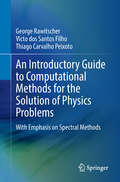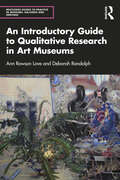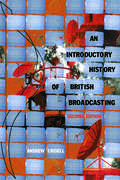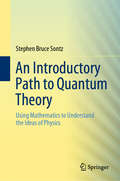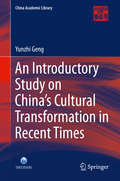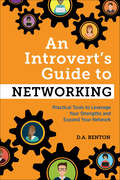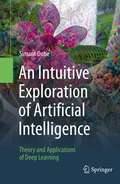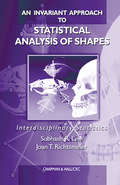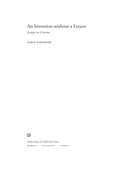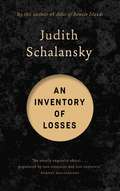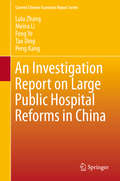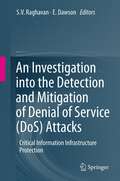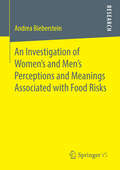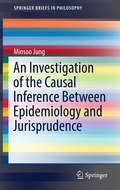- Table View
- List View
An Introductory Guide to Computational Methods for the Solution of Physics Problems (Lecture Notes in Physics #955)
by George Rawitscher Victo dos Santos Filho Thiago Carvalho PeixotoThis monograph presents fundamental aspects of modern spectral and other computational methods, which are not generally taught in traditional courses. It emphasizes concepts as errors, convergence, stability, order and efficiency applied to the solution of physical problems. The spectral methods consist in expanding the function to be calculated into a set of appropriate basis functions (generally orthogonal polynomials) and the respective expansion coefficients are obtained via collocation equations. The main advantage of these methods is that they simultaneously take into account all available information, rather only the information available at a limited number of mesh points. They require more complicated matrix equations than those obtained in finite difference methods. However, the elegance, speed, and accuracy of the spectral methods more than compensates for any such drawbacks. During the course of the monograph, the authors examine the usually rapid convergence of the spectral expansions and the improved accuracy that results when nonequispaced support points are used, in contrast to the equispaced points used in finite difference methods. In particular, they demonstrate the enhanced accuracy obtained in the solution of integral equations.The monograph includes an informative introduction to old and new computational methods with numerous practical examples, while at the same time pointing out the errors that each of the available algorithms introduces into the specific solution. It is a valuable resource for undergraduate students as an introduction to the field and for graduate students wishing to compare the available computational methods. In addition, the work develops the criteria required for students to select the most suitable method to solve the particular scientific problem that they are confronting.
An Introductory Guide to Qualitative Research in Art Museums (Routledge Guides to Practice in Museums, Galleries and Heritage)
by Ann Rowson Love Deborah RandolphAn Introductory Guide to Qualitative Research in Art Museums is a practice-based guide that is designed to introduce qualitative research to established and upcoming museum professionals and increase their confidence to conduct this type of research. Highlighting the work of researchers who are studying museums around the world, the book begins by explaining why there is a need for qualitative research in museums. Rowson Love and Randolph then go on to provide guidance, including theories and frameworks, on how to envision a qualitative research project that facilitates meaningful interpretation of visitor experiences. Chapters in the methodology section begin with descriptions of featured qualitative methodologies and will assist readers as they determine which are most appropriate for their projects and as they advocate for their research. The final section will prepare readers still further by demonstrating data analysis and reporting using the examples in the book. An Introductory Guide to Qualitative Research in Art Museums will help museum professionals and students engaged in the study of museums expand their repertoire to include qualitative methodologies and explain the methods needed to conduct, analyze, and report their qualitative research. It will be particularly useful to those with an interest in museum education, visitor studies and audience research, exhibition development, leadership, and management.
An Introductory History of British Broadcasting
by Andrew CrisellAn Introductory History of British Broadcasting is a concise and accessible history of British radio and television. It begins with the birth of radio at the beginning of the twentieth century and discusses key moments in media history, from the first wireless broadcast in 1920 through to recent developments in digital broadcasting and the internet.Distinguishing broadcasting from other kinds of mass media, and evaluating the way in which audiences have experienced the medium, Andrew Crisell considers the nature and evolution of broadcasting, the growth of broadcasting institutions and the relation of broadcasting to a wider political and social context. This fully updated and expanded second edition includes:*the latest developments in digital broadcasting and the internet*broadcasting in a multimedia era and its prospects for the future*the concept of public service broadcasting and its changing role in an era of interactivity, multiple channels and pay per view*an evaluation of recent political pressures on the BBC and ITV duopoly*a timeline of key broadcasting events and annotated advice on further reading.
An Introductory History of British Broadcasting
by Andrew CrisellAn Introductory History of British Broadcasting is a concise and accessible history of British radio and television. It begins with the birth of radio at the beginning of the twentieth century and discusses key moments in media history, from the first wireless broadcast in 1920 through to recent developments in digital broadcasting and the internet.Distinguishing broadcasting from other kinds of mass media, and evaluating the way in which audiences have experienced the medium, Andrew Crisell considers the nature and evolution of broadcasting, the growth of broadcasting institutions and the relation of broadcasting to a wider political and social context. This fully updated and expanded second edition includes:*the latest developments in digital broadcasting and the internet*broadcasting in a multimedia era and its prospects for the future*the concept of public service broadcasting and its changing role in an era of interactivity, multiple channels and pay per view*an evaluation of recent political pressures on the BBC and ITV duopoly*a timeline of key broadcasting events and annotated advice on further reading.
An Introductory Path to Quantum Theory: Using Mathematics to Understand the Ideas of Physics
by Stephen Bruce SontzSince the 17th century, physical theories have been expressed in the language of mathematical equations. This introduction to quantum theory uses that language to enable the reader to comprehend the notoriously non-intuitive ideas of quantum physics. The mathematical knowledge needed for using this book comes from standard undergraduate mathematics courses and is described in detail in the section Prerequisites. This text is especially aimed at advanced undergraduate and graduate students of mathematics, computer science, engineering and chemistry among other disciplines, provided they have the math background even though lacking preparation in physics. In fact, no previous formal study of physics is assumed.
An Introductory Study on China's Cultural Transformation in Recent Times (China Academic Library)
by Yunzhi GengThis book examines in detail the basic trajectory of the cultural transformation and brings to light the extrinsic conditions and intrinsic mechanisms involved. It focuses on the period from after the Opium Wars to the New Culture Movement, as the New Culture Movement can be considered a pivotal phase in the cultural transformation of modern-day China. The New Culture Movement was a revolutionary eruption triggered by the accumulation of all the new qualitative cultural factors since the Opium Wars. Superficially, the movement's goal seemed to be to overthrow the traditional culture. But in essence its true objective was to conduct an overall "screening" of that culture. The book elaborates a broad variety of points in this context, including: the ideological and cultural evolution following the Opium Wars; the pressing challenges faced by "Zhong Ti"; the initial shaping of social, public and cultural spaces and major trends in ideological and cultural transformation at the end of the Qing Dynasty; the political disarray and conflicts between the new and old ideology in the first years of the Republic; the rise of the New Culture Movement; and the role of conservatism in the transition to a modern culture.
An Introvert's Guide to Networking: Practical Tools to Leverage Your Strengths and Expand Your Network
by D A BentonEncouraging and practical advice to help introverts improve their networking skillsProfessional networking can seem overwhelming, especially if you're introverted in social situations. An Introvert's Guide to Networking is here to make it easier, with everyday advice that helps you leverage your natural strengths like listening, observation, and careful thought, to create connections in ways that feel comfortable and genuine for you.An Introvert's Guide to Networking offers:Helpful, hands-on guidance—Learn networking tips like how to enter (and exit) conversations gracefully, optimize your social media presence, be aware of your body language, and more.Advice for everyone—These inclusive techniques are helpful for people of all career stages, industries, and social skill levels—even extroverts might learn a thing or two.Real examples—Read quotes and anecdotes from introverts who've used their authentic personalities to make successful professional relationships.Start networking more productively today with a book that makes it easier for introverts.
An Intuitive Exploration of Artificial Intelligence: Theory and Applications of Deep Learning
by Simant DubeThis book develops a conceptual understanding of Artificial Intelligence (AI), Deep Learning and Machine Learning in the truest sense of the word. It is an earnest endeavor to unravel what is happening at the algorithmic level, to grasp how applications are being built and to show the long adventurous road in the future.An Intuitive Exploration of Artificial Intelligence offers insightful details on how AI works and solves problems in computer vision, natural language understanding, speech understanding, reinforcement learning and synthesis of new content. From the classic problem of recognizing cats and dogs, to building autonomous vehicles, to translating text into another language, to automatically converting speech into text and back to speech, to generating neural art, to playing games, and the author's own experience in building solutions in industry, this book is about explaining how exactly the myriad applications of AI flow out of its immense potential.The book is intended to serve as a textbook for graduate and senior-level undergraduate courses in AI. Moreover, since the book provides a strong geometrical intuition about advanced mathematical foundations of AI, practitioners and researchers will equally benefit from the book.
An Intuitive Introduction to Finance and Derivatives: Concepts, Terminology and Models (Springer Texts in Business and Economics)
by Alex BackwellThis book gives a self-contained, intuitive overview of some of the most important topics of finance, such as investment risk, market pricing and market efficiency, arbitrage, hedging, and the pricing and application of financial derivatives. It provides a first-principles introduction to the relevant material and concepts, emphasising intuition. Financial terminology, and the understanding implicit therein, is carefully introduced. The books starts with finance in the most general terms, and gradually specialises to investment theory and then derivatives. This book is tailor-made for readers new to finance, such as graduate students entering or interested in finance, or financial practitioners moving to a more quantitative role.
An Invariant Approach to Statistical Analysis of Shapes (Chapman & Hall/CRC Interdisciplinary Statistics)
by Subhash R. Lele Joan T. RichtsmeierNatural scientists perceive and classify organisms primarily on the basis of their appearance and structure- their form , defined as that characteristic remaining invariant after translation, rotation, and possibly reflection of the object. The quantitative study of form and form change comprises the field of morphometrics. For morphometrics to suc
An Invention without a Future
by James NaremoreIn 1895, Louis Lumière supposedly said that cinema is "an invention without a future." James Naremore uses this legendary remark as a starting point for a meditation on the so-called death of cinema in the digital age, and as a way of introducing a wide-ranging series of his essays on movies past and present. These essays include discussions of authorship, adaptation, and acting; commentaries on Howard Hawks, Alfred Hitchcock, Orson Welles, Vincente Minnelli, John Huston, and Stanley Kubrick; and reviews of more recent work by non-Hollywood directors Pedro Costa, Abbas Kiarostami, Raúl Ruiz, and Apichatpong Weerasethakul. Important themes recur: the relations between modernity, modernism, and postmodernism; the changing mediascape and death of older technologies; and the need for robust critical writing in an era when print journalism is waning and the humanities are devalued. The book concludes with essays on four major American film critics: James Agee, Manny Farber, Andrew Sarris, and Jonathan Rosenbaum.
An Inventory of Losses: LONGLISTED FOR THE INTERNATIONAL BOOKER PRIZE 2021
by Judith Schalansky"A fine example of everyone's favourite genre: the genre-defying book, inspired by history, filtered through imagination and finished with a jeweller's eye for detail" JOHN SELF, Guardian"As we deal with the consequences, emotional and material, of a pandemic, it is hard to imagine a better guide to the resources of hope than Schalansky's deeply engaging inventory" MICHAEL CRONIN, Irish Times"Weaving fiction, autobiography and history, this sumptuous collection of texts offers meditations on the diverse phenomena of decomposition and destruction" Financial Times "Books of the Year""Pure gold storytelling" SJONJudith Schalansky's strange and wonderful new book, recalling writers as different as W.G. Sebald and Christa Wolf, Joan Didion and Rebecca Solnit, sees her return to the territory she explored so successfully with her best-selling Atlas of Remote Islands: Fifty Islands I Have Never Set Foot On and Never Will, which Robert MacFarlane called "utterly exquisite" (Guardian) and about which Time Out's reviewer said "Rarely has armchair travel been so farflung and romantic".Judith Schalansky is a wholly original writer whose books articulate perfectly what she wishes to say. Each of the pieces, following the conventions of a different genre, considers something that is irretrievably lost to the world, including the paradisal pacific island of Tuanaki, the Caspian Tiger, the Villa Sacchetti in Rome, Sappho's love poems, Greta Garbo's fading beauty, a painting by Caspar David Friedrich, and the former East Germany's Palace of the Republic. As a child of the former East Germany, it's not surprising that the dominant emotion in Schalansky's work should be "loss" and its aftermath, but what is extraordinary is the thoroughly engaging mixture of intellectual curiosity, down-to-earth grasp of life's pitiless vitality, ironic humour, stylistic elegance and intensity of feeling that combine to make this book a masterpiece and one of the most original and beautifully designed books to be published in 2020.Translated from the German by Jackie Smith
An Investigation Report on Large Public Hospital Reforms in China (Current Chinese Economic Report Series #0)
by Lulu Zhang Meina Li Feng Ye Tao Ding Peng KangThis book provides a comprehensive understanding of public hospital reform in China, which is a hot topic for China's new round of health sector reform. The authors use rich data from both health provider side and service user side and conduct a cross-sectional study in China with some comparative analysis between different locations. It provides the audience with a big picture of China's public hospital and other components of health system as well. The book reviews the main policy measurements in the public hospital reforms and evaluates how these policies influence public hospitals' practices, especially on hospital governance and internal management.
An Investigation into the Detection and Mitigation of Denial of Service (DoS) Attacks: Critical Information Infrastructure Protection
by E Dawson S. V. RaghavanAround the globe, nations face the problem of protecting their Critical Information Infrastructure, normally referred to as Cyber Space. In this monograph, we capture FIVE different aspects of the problem; High speed packet capture, Protection through authentication, Technology Transition, Test Bed Simulation, and Policy and Legal Environment. The monograph is the outcome of over three years of cooperation between India and Australia.
An Investigation of Output Variance Before and During Inflation Targeting
by Francisco Nadal-De SimoneA report from the International Monetary Fund.
An Investigation of Some Macro-Financial Linkages of Securitization
by Andreas Jobst Mangal Goswami Xin LongA report from the International Monetary Fund.
An Investigation of Women's and Men's Perceptions and Meanings Associated with Food Risks
by Andrea BiebersteinConcern about food risks is widespread. Consumers, however, are found to differ in terms of how they evaluate these risks. One of the most prominent findings in this regard is the differences between women and men. Many studies report that men are less worried about environmental and technological risks than women, which is also the case for food risks. At the same time it is criticized that these differences are often exaggerated, similarities overlooked, and systematic investigations are lacking. Andrea Bieberstein gives a comprehensive overview of theoretical approaches to risk perception and empirical work that has been conducted in the field of risk perception research. Furthermore, she provides a systematic investigation of how food risks are constructed for women and men by uncovering the meanings in terms of associations, feelings, and values that they attach to various food risks. This allows a deeper understanding of the gender differences in risk perception in terms of their relevance and meaning.
An Investigation of the Causal Inference between Epidemiology and Jurisprudence (SpringerBriefs in Philosophy)
by Minsoo JungThis book examines how legal causation inference and epidemiological causal inference can be harmonized within the realm of jurisprudence, exploring why legal causation and epidemiological causation differ from each other and defining related problems. The book also discusses how legal justice can be realized and how victims' rights can be protected. It looks at epidemiological evidence pertaining to causal relationships in cases such as smoking and the development of lung cancer, and enables readers to correctly interpret and rationally use the results of epidemiological studies in lawsuits. The book argues that in today's risk society, it is no longer possible to thwart the competence of evidence using epidemiological research results. In particular, it points out that the number of cases that struggle to prove a causal relationship excluding those using epidemiological data will lead to an increase in the number of lawsuits for damages that arise as a result of harmful materials that affect our health. The book argues that the responsibility to compensate for damages that have actually occurred must be imputed to a particular party and that this can be achieved by understanding causal inferences between jurisprudence and epidemiology. This book serves as a foundation for students, academics and researchers who have an interest in epidemiology and the law, and those who are keen to discover how jurisprudence can bring these two areas together.
An Investigation of the Laws of Thought
by George BooleGeorge Boole was on of the greatest mathematicians of the 19th century, and one of the most influential thinkers of all time. Not only did he make important contributions to differential equations and calculus of finite differences, he also was the discoverer of invariants, and the founder of modern symbolic logic. According to Bertrand Russell, "Pure mathematics was discovered by George Boole in his work published in 1854."This work is the first extensive statement of the modern view that mathematics is a pure deductive science that can be applied to various situations. Boole first showed how classical logic could be treated with algebraic terminology and operations, and then proceeded to a general symbolic method of logical interference; he also attempted to devise a calculus of probabilities which could be applied to situations hitherto considered beyond investigation.The enormous range of this work can be seen from chapter headings: Nature and Design of This Work; Signs and Their Laws; Derivation of Laws; Division of Propositions; Principles of Symbolical Reasoning; Interpretation; Elimination; Reduction; Methods of Abbreviation; Conditions of a Perfect Method; Secondary Propositions; Methods in Secondary Propositions; Clarke and Spinoza; Analysis, Aristotelian Logic; Theory of Probabilities; General Method in Probabilities; Elementary Illustrations; Statistical Conditions; Problems on Causes; Probability of Judgments; Constitution of the Intellect. This last chapter, Constitution of the Intellect, is a very significant analysis of the psychology of discovery and scientific method.
An Investigative Cinema: Politics and Modernization in Italian, French, and American Film
by Fabrizio CilentoThis book traces the development of investigative cinema, whose main characteristic lies in reconstructing actual events, political crises, and conspiracies. These documentary-like films refrain from a simplistic reconstruction of historical events and are mainly concerned with what does not immediately appear on the surface of events. Consequently, they raise questions about the nature of the “truth” promoted by institutions, newspapers, and media reports. By highlighting unanswered questions, they leave us with a lack of clarity, and the questioning of documentation becomes the actual narrative. Investigative cinema is examined in relation to the historical conjunctures of the “economic miracle” in Italy, the simultaneous decolonization and reordering of culture in France, the waves of globalization and neoliberalism in post-dictatorial Latin America, and the post-Watergate, post-9/11 climate in US society. Investigative cinema is exemplified by the films Salvatore Giuliano, The Battle of Algiers, The Parallax View, Gomorrah, Zero Dark Thirty, and Citizenfour.
An Investment Perspective on Global Value Chains
by Yan Liu Christine Zhenwei Qiang Victor SteenbergenThis report investigates the role of foreign direct investment (FDI) in helping developing countries participate in global value chains (GVCs). It combines the perspectives and strategies from three types of players: multinational corporations, domestic firms and governments. It aims to provide practical guidance for developing countries to develop strategies that use FDI to strengthen GVC participation and upgrading. The report has six main chapters: 1. FDI and GVCs. Assesses the trade-investment nexus and analyzes the effect of FDI in countries’ GVC participation and upgrading at the country level. 2. MNCs shape GVC development. Highlights MNCs' contribution to global economy and how their business strategies shape the evolution of GVCs. The chapter also compares MNCs' business strategies in terms of outsourcing and offshoring, risk mitigation and increasing market power across GVC archetypes. 3. Domestic firm perspectives on GVC participation. Looks at the various paths domestic firms can take to internationalize their production and trade. Investigates domestic firm characteristics that predict higher GVC participation, and the effect of GVC participation on firm performance. 4. Investment policy and promotion: what is in a government’s toolbox? Summarizes the various policy instruments governments have at their disposal to help attract MNCs to their country and facilitate GVC participation of domestic firms. 5. Integrating countries into GVCs. Draws on a range of case studies to illustrate how governments can develop coherent strategies and policy packages to integrate their countries into GVCs. 6. FDI and GVCs in the wake of COVID-19. Reflects the impact of COVID-19 on FDI and GVCs, the response from multinationals and suppliers, and the implications for GVC reconfiguration. In addition, there are seven case studies that offer more nuanced analysis on the GVC participation in selected countries and sectors: • Five qualitative case studies: Five countries have been selected that managed to use FDI to stimulate GVC participation using a range of approaches. By design, these five countries also cover five different GVC archetypes. These countries are: (1) Kenya (horticulture); (2) Dominican Republic (textiles); (3) Mauritius (tourism); (4) Malaysia (electronics); (5) China (software). • Two quantitative case studies: Rwanda, West-Bengal (India). These use a combination of firm- and transaction level datasets to study firm-level dynamics that explain the role of multinational and domestic firms across GVCs.
An Invincible Beast: Understanding the Hellenistic Pike Phalanx in Action
by Christopher MatthewThe Hellenistic pike-phalanx was a true military innovation, transforming the face of warfare in the ancient world. For nearly 200 years, from the rise of the Macedonians as a military power in the mid-fourth century BC, to their defeat at the hands of the Romans at Pydna in 168BC, the pike-wielding heavy infantryman (the phalangite) formed the basis of nearly every Hellenistic army to deploy on battlefields stretching from Italy to India. And yet, despite this dominance, and the vast literature dedicated to detailing the history of the Hellenistic world, there remains fierce debate among modern scholars about how infantry combat in this age was actually conducted.Christopher Matthews critically examines phalanx combat by using techniques such as physical re-creation, experimental archaeology, and ballistics testing, and then comparing the findings of this testing to the ancient literary, artistic and archaeological evidence, as well as modern theories. The result is the most comprehensive and up-to-date study of what heavy infantry combat was like in the age of Alexander the Great and his successors.
An Invincible Spirit: The Story of Don Fulk
by Janet Allen“Don taught us how to be a real independent living center. Nothing was easy; every issue that came up on the road to Don’s independence was a challenge and a struggle, but the experience pushed us and we learned from it. We were not going to let Don down; all of us were committed to Don’s freedom and independence.” —Kathleen Kleinman, Executive Director, TRPIL (Transitional Paths to Independent Living) Profoundly deafened as an infant, Don Fulk didn’t learn his name or go to school until the age of ten. When he was eighteen years old and a budding superstar on his football and basketball teams, he broke his neck in a swimming accident, and became paralyzed. After his injury, he was confined to a bed in his parents’ home for eight years, unable to move and barely able to communicate. After his family could no longer care for him, he spent nine years in a nursing home where he suffered from abuse and neglect. Yet through a life marred by isolation and frustration, Fulk endured with strength, humor, and grace. He never gave up pursuing his dreams for independence and self-worth, and improving the lives of others. He fought a system that was unfair and discriminatory, and helped pave the way for people with disabilities to live independently. Don Fulk signed his story to author Janet Allen, describing his difficult home life, the incredible friends who changed his life, and his dramatic escape from an abusive nursing home. An Invincible Spirit is a story of hope, empowerment, and the battles people with disabilities have fought—and continue to fight—to improve the quality of their lives.
An Invincible Spirit: The Story of Don Fulk
by Janet Allen“Don taught us how to be a real independent living center. Nothing was easy; every issue that came up on the road to Don’s independence was a challenge and a struggle, but the experience pushed us and we learned from it. We were not going to let Don down; all of us were committed to Don’s freedom and independence.” —Kathleen Kleinman, Executive Director, TRPIL (Transitional Paths to Independent Living) Profoundly deafened as an infant, Don Fulk didn’t learn his name or go to school until the age of ten. When he was eighteen years old and a budding superstar on his football and basketball teams, he broke his neck in a swimming accident, and became paralyzed. After his injury, he was confined to a bed in his parents’ home for eight years, unable to move and barely able to communicate. After his family could no longer care for him, he spent nine years in a nursing home where he suffered from abuse and neglect. Yet through a life marred by isolation and frustration, Fulk endured with strength, humor, and grace. He never gave up pursuing his dreams for independence and self-worth, and improving the lives of others. He fought a system that was unfair and discriminatory, and helped pave the way for people with disabilities to live independently. Don Fulk signed his story to author Janet Allen, describing his difficult home life, the incredible friends who changed his life, and his dramatic escape from an abusive nursing home. An Invincible Spirit is a story of hope, empowerment, and the battles people with disabilities have fought—and continue to fight—to improve the quality of their lives.
An Invisible Minority: The History, Society and Politics of Sikhs in Kashmir
by Komal JB SinghThis book presents a groundbreaking study of the Kashmiri Sikh community, examining how identities are formed and negotiated across the intersections of religion, region, and nation. Combining deep ethnographic engagement with historical analysis, it examines Kashmir beyond the hegemonic boundaries of the Hindu-Muslim binary, by foregrounding an alternative discourse to see how majority–minority relations in a volatile region like Kashmir unfold, how the Sikh minority within the minorities is silenced in everyday discourses, and how all minorities are pushed to the margins. The author studies the themes of alienation, moments of solidarity, and cooperation between the various communities in Kashmir. This book traces the rich and often untold history of Sikhs in Kashmir from the visits of various Gurus, Maharaja Ranjit Singh rule to Singh Sabha Movement. It explores the traumatic history of partition, 1984 violence to Chittisinghpora Massacre. Thus, it traces a journey of faith, reform, and resilience.Numerically, Sikhs presently are the largest minority community living in Kashmir presently and therefore, crucial to any understanding of Kashmir. The book will be of use to students and researchers of history, Sikh studies, sociology, religion, minority studies, anthropology, and South Asian studies.
